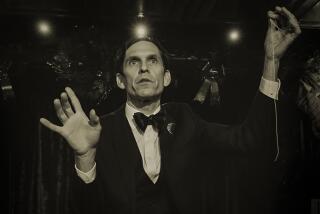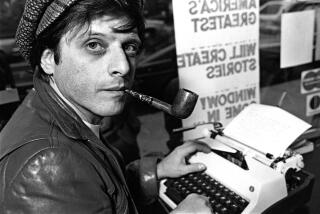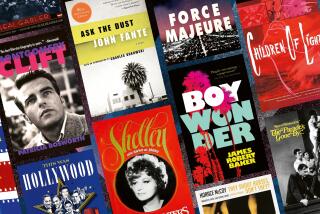Chance to See the Wonderful Wizard of ‘Oz’ : The ‘Road to Oz’ display at the Frances Howard Goldwyn branch library in Hollywood acquaints visitors with the life and works of author L. Frank Baum
Hollywood seems an indelicate place to house a history of something as sweet as the works of L. Frank Baum. The neighborhood of the handsome Frances Howard Goldwyn branch of the Los Angeles Public Library, where “The Road to Oz: The Life of L. Frank Baum” is on display, is pretty well inhabited by the same types of struggling souls regularly seen sleeping on the stars of nearby Hollywood Boulevard.
And yet, in a way, it would seem inappropriate to place such an exhibit anywhere else. Baum, after all, spent the last 10 years of his life in Hollywood, at a beloved home he called “Ozcot.” Hollywood itself is nearly as much of a myth as Oz is, and as for struggling souls, well, Baum--prolific author, newspaper editor, salesman of axle grease and castor oil, motion picture studio head, lifelong victim of a frail heart--knew his share of bankruptcy and strife.
“Nobody really knows very much about Frank Baum,” said exhibit director-curator Carroll Hodge, a free-lance documentary filmmaker and member of the film school faculty at USC. “In fact, I didn’t really know who Frank Baum was. I did not read the Oz books when I was a child. I discovered them in doing this project.”
Hodge is an exemplary case of what she hopes will happen to everyone who tours the Baum exhibit (running through Aug. 31)--that they will come to understand that Lyman Frank Baum was not, as popular assumption goes, just a nice old fellow who wrote a children’s story.
“I found that the books were quite a bit different from the 1939 film,” said Hodge, who was charged to assemble the exhibit by the Samuel Goldwyn Foundation as part of an ongoing effort to honor writers who lived in Los Angeles (“And,” said senior librarian John Holliman, “to promote reading!”) “I found that Frank Baum’s stories had a sly humor and the whole philosophical bent of not giving too much power away. I thought that was very contemporary. We all go looking for the wizard, and when he’s a humbug, he reminds us that we already had that power within us. I like Baum’s very full, coherent philosophy, and it’s played out in wonderful characters, and that appealed to me a lot as an adult.”
The wonderful characters are all at the exhibit in the form of charming, life-sized cutout paintings done by designer Deni Wohlgemuth Ponty. Upstairs, General Jinjur--Baum’s parody of a suffragist (the author favored equality for women, but could not suffer any form of militancy--watches over a portion of the children’s section. Prof. H.M. (Highly Magnified) Wogglebug, T.E. (Thoroughly Educated)--Baum’s sendup of academic snobbery--stands pompously near a Rand McNally Commercial Atlas and Marketing Guide. Downstairs, entrants are greeted with an imitation “Yellow Brick Road,” one of Oz’s crabby apple trees, the Cowardly Lion, “the Most Intelligent Beast in Oz;” the Tin Woodman, “the Kindliest Man in Oz”; the Scarecrow, “the Wisest Man in All of Oz”; and other faces familiar in the Emerald City--notably, of course, that of Dorothy Gale, stalwart survivor of cyclones and witches’ spells.
“I have several theories as to why Baum had a girl for a central character in the Oz books,” said Hodge, “but it probably would be safe to say that he always wanted a little girl and didn’t have one. I think he created a girl character who appealed to boys also; a girl heroine who was adventuresome and courageous and yet girlish. What did she want? She wanted to go home. And also on the subject of heroines, not only is Dorothy an important character, but all the rulers of Oz are women. Once the wizard is sort of dethroned, Ozma and Glinda the Good Witch take over.”
The “Road” in “The Road to Oz” is a well-researched, detailed time line history of Baum’s life, complete with mementos and photos (provided by Baum descendants and Oz devotees). Visitors are invited to follow the author’s career in 19 stops throughout the library, punctuated by more of Ponty’s renderings of the various citizens of Munchkinland and Winkie Country. “I was surprised,” Hodge said, “at how many people stop to read every word.”
A 25-minute video documentary featuring choice samplings of Baum’s own highly surreal movie versions of his stories, done in 1914 by his Oz Film Manufacturing Co., runs continuously downstairs, with narration by admitted Oz-buff Charlton Heston. Norman Rockwell’s painting of Judy Garland as Dorothy, commissioned by Gregory Peck, hangs on an upstairs wall; a replica of a 1914 toy Woozy, a magical wooden beast, made by Baum’s great-grandson, Robert, is encased in glass; a stubby old pencil mounted and framed is captioned in Baum’s own script, “With this pencil, I wrote the Ms. of ‘The Emerald City’ (later changed to “The Wonderful Wizard of Oz”), Oct. 9, 1899.”
Aside from the humble pencil that yielded what many say is America’s greatest fairy tale, perhaps two other features of the exhibit stand out most; one, an excerpted letter in which author John Steinbeck asks President Kennedy if he could be appointed U.S. Ambassador to Oz (“There is only one great danger that I can think of,” wrote Steinbeck. “In Oz they have a wizard who openly admits that he is a fake. Can you think what that principle would do to New York politics alone?”) and two, “the Gump.” Right, the sofa-bed-and-elk’s-head creature that, after a sprinkling of the Magic Powder of Life, spirited the Scarecrow and his companions away from the clutches of General Jinjur.
“One of the exhibit’s physical objects that I am actually most fond of is the Gump,” Hodge said. “There’s a little story by a Baum niece that when she stayed overnight with her Uncle Frank and Aunt Maud, they pushed the couch to the wall, and made a little bed for her, and it was very much in the spirit of fun kids have always had in pushing furniture together and making something imaginative from it. I feel like that Gump couch (upstairs in the children’s section) is kind of a physical 3-D element that lets kids connect with Frank Baum’s imagination on a very immediate kind of way. They can climb in and read books, and they can enjoy the fact that the Gump was a character that came to life. And if they want to imagine they can fly away in it, that would be fine, too.”
There were times in Baum’s own life when he perhaps wished to fly away on a magic couch--perhaps, most surprisingly, to escape from Oz itself. A compulsive writer of more than 60 books--including many adventure tales written under pen names such as Capt. Hugh Fitzgerald and Suzanne Metcalf--he tried to end the Oz series with “The Emerald City” in 1910 (he made the place invisible to the outside world). He vowed to not pen another word about Oz until “a thousand little children write a thousand little letters.” Within a few months, they had, and Baum was to grind out eight more adventures in the “merry old land” before his death in 1919. One of the post-”thousand little letter” books was “The Patchwork Girl of Oz”--which happens to be the favorite Oz work of Baum’s only living grandchild, Ozma Baum Mantele.
“Patchwork Girl” appealed to me so much that I changed my name to Scraps, and everybody started calling me Scraps,” said Mantele, speaking from her home in Downey. “With my name, Ozma, I never knew who were my friends and who weren’t. I had a hard time with my name when I was younger.”
Named after the gentle princess of Oz, Mantele was cherished by Baum, the father of four sons. Her memories of grandfather consist only of “flashes” from the age of 3, but to this day she wears a diamond and gold locket inscribed with her name presented by her grandfather upon her birth. She does have favorite Baum tales, though, passed down by her grandmother, Maud Gage Baum. Among them: that Baum was especially proud of a letter from a New York polio clinic saying that his books went hand-in-hand with a thermometer; that once a child touched him because “he wanted to know what the wizard felt like”; and, while visiting Egypt, he was deeply moved by a little girl who, while moving to Cairo with her family, had crossed the desert on camelback with only a doll and an Oz book--which he promptly autographed. Mantele, who helped Hodge with research, heartily approves of “The Road to Oz.”
“I like this exhibit because it shows that he was very multitalented and wrote many more things besides the ‘Wizard,’ ” said Mantele, who has long given slide presentations on her grandfather’s life. “He was very multifaceted, actually. And he also raised chrysanthemums, and got cups for those--anything he put his hand to, he could do. And I also like the video with Heston’s narration because it showed my grandfather’s studio, and all the innovations. He was way ahead of his time as far as motion picture special effects are concerned.”
Indeed, “The Patchwork Girl of Oz” movie from 1914--clips of which may be seen in Hodge’s video--includes underwater effects, flying scenes and a startling moment in which Mombi the Witch is temporarily beheaded. Among Baum’s other multitudinous facets: publishing the Saturday Pioneer newspaper in South Dakota in 1890, where he first made his mark as a satirist; touring as a Shakespearean actor in 1881 under the name of George Brooks; receiving national acclaim for his play, “The Maid of Arran” in 1882; selling axle grease and castor oil in 1891 to bring in money after his first of several bankruptcies.
“This man had struggled for years to get published--maybe five years, or so,” Hodge said. “And how often he went bankrupt, or his publishers went bankrupt, or his film company went bankrupt! He weathered many hard times--he had a heart attack at the age of 12--and I think he had a certain buoyancy, and a certain outlook on life that just kept him going.”
To say nothing of a certain place.
“The Road to Oz: The Life of L. Frank Baum”
At the Frances Howard Goldwyn Hollywood Public Library, 1623 Ivar Ave., (213) 467-1821
Open 10 a.m. to 8 p.m. Monday through Thursday; to 5:30 p.m. Friday and Saturday.
More to Read
Sign up for The Wild
We’ll help you find the best places to hike, bike and run, as well as the perfect silent spots for meditation and yoga.
You may occasionally receive promotional content from the Los Angeles Times.






